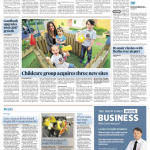Richer paid-for news content that gives better value to readers will offer print media a much needed revenue stream and a new opportunity for PR agencies that choose to take it.
In the week gone by, the Sunday Business Post featured commentary from Adrian Weckler on the new pay wall being introduced by The Times and Sunday Times in the UK.
Previously we argued against pay walls for newspapers. In the age of copy and paste, previous attempts to offer paid-for online content descended into farce.
We put forward a licensing model that would both subsidise the production of material while also ensuring that it was read. We still believe that paying for content reproduced from print editions is still a non-starter but The Times are offering a unique model that, if broadly adopted, presents PR with an excellent opportunity.
As well as the original print version of an article, The Times will be offering additional content in the form of analysis and multimedia content, in exchange for £2 per week or £1 per day. By meeting the consumer half way by offering more for a manageable sum, the newspaper group may well be successful in generating direct revenues from content.
As most who work in the media know at present, there is an increasing amount of pressure on journalists to create content as staff numbers are trimmed and the demands for more content in the information age increases. If Irish papers were to adopt this model they will be faced with the challenge of producing additional content from already over-taxed news rooms.
Another online revenue model is also about to become increasingly relevant in Europe. The success of the iPad in the USA has put pressure on magazines there to get their content into iPad apps. Given the nature of the format, app versions of popular magazines are offering a range of multimedia content to subscribers on phones and tablet computers.
We believe that both of the above create a tremendous opportunity for the PR industry and for future PR graduates.
PR companies already have a long track record of producing strong written and photographic content, but now we must be able to offer publications a lot more. The agency of today need to have the skills to create rich animated infographics, video and strong journalistic copy written for the web. Some media may be concerned at having their objectivity assailed as the lure of free PR content needs to balanced with independence. PR must ensure that they produce this content in a balanced manner and in a sense, think more like journalists or the opportunity will pass the industry by.
The content case study for Ireland may yet to be produced but we feel that if Irish papers follow The Times’ lead, the PR agency of 2010 will both have opportunity and the obligation to provide content. Next generation PR executives would do well to hone their web programming and design skills as well as those for online video production and content optimisation. A good article on the skills PR pros of tomorrow will need can be found here.
The addition of rich multimedia to sell content is not without precedent. The mid 90’s obsession with CD ROMs failed before, with the shiny discs becoming an expensive appendage as people just wanted to read the magazine without turning on their PC. With the unprecedented growth of smartphones and tablets perhaps this is the coming of age of multimedia for the press organisations and a trend that PR will have to grasp with both hands.





